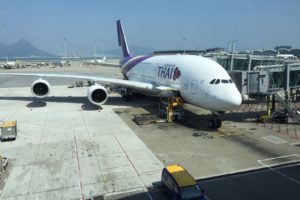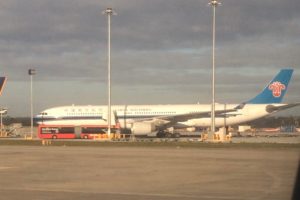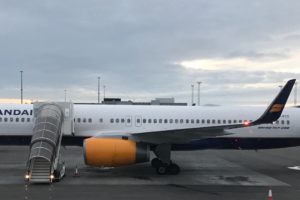Airline Profile: Aer Lingus
The Facts:
| Alliance | N/A |
| Competitors | Ryanair |
| Fleet Count | Around 55 |
| Founded | 1936 |
| Frequent Flyer Program | AerClub |
| Headquarters | Dublin, Ireland |
| Major Focus Cities | Dublin Airport Cork Airport Belfast City Airport Shannon Airport |
| Parent Company | IAG |
| Skytrax Rating | 4 (out of 5) |
| Subsidiaries | Aer Lingus Regional |
| Travel Classes | Economy |
| Type of Airline | Full Service |
| Website | aerlingus.com |

Analysis:
7 Things You Need To Know About Aer Lingus
- Aer Lingus is now a wholly owned subsidiary of the International Airlines Group or IAG. It was acquired in 2015, nine years after being privatized (it was previously owned by the Irish Government). IAG is the same holding company that owns Oneworld Airlines British Airways and Iberia, and also owns Vueling, Level, and a minority stake in Comair. However, unlike the two largest airlines in IAG, Aer Lingus is not a member of Oneworld; it was a part of the alliance until 2007, and surprisingly didn’t reenter after it was purchased.
- Aer Lingus’ central hub is at Dublin Airport, from which it operates to many airports throughout Europe, a large amount of which within Ireland and to the United Kingdom. Aer Lingus has a vast transatlantic route network, and flies to a variety of destinations in North America using its long-haul fleet of A330s and 757s, from Dublin to Toronto, Boston, Hartford, Chicago, Los Angeles, Miami Minneapolis, New York (JFK), Newark, Orlando, Philidelphia, San Francisco, Seattle, and Washington Dulles. Also, Aer Lingus uses its 757s to fly from Shannon to New York JFK year round and Boston, summer seasonally.
- Aer Lingus currently leases a fleet of four Boeing 757-200s which feature lie-flat seats in business class and personal on-demand entertainment which it uses to fly from Shannon to New York and Boston, and from Dublin to Hartford, Philidelphia, and Washington Dulles (seasonally). These aircraft are slated to be eight Airbus A321LRs, which will be used to grow their transatlantic route network and replace their 757s in addition to operating select intra-European flights.
- Aer Lingus is unique in that it currently does not offer a short-haul business class product as most European legacy carriers do. They used to until 2002, until they got rid of it. Fortunately, they will be introducing a new short-haul business class product which they call AerSpace. It will be added on September 1, 2019, and will be pretty standard for European business class products, as the seats will only feature the same standard economy seats with the middle seat free. Additionally, passengers will get priority boarding and check-in, lounge access, free food (off of the economy class menu) and a higher baggage allowance. As I always say, unless business class comes with a connecting long-haul in a premium cabin, I don’t recommend splurging the extra miles or money for business class as the seat is still the same as in economy and the soft product and baggage allowance most often isn’t worth the price.

- Aer Lingus technically can be considered a low-cost airline on its intra-European routes, as it has lower fares in economy class on most routes than legacy carriers and doesn’t offer free food or baggage on intra-European routes, and also as it didn’t have a short-haul business class product. However, Aer Lingus is shifting toward becoming a full-service airline on European routes with the introduction of business class on those routes. On long-haul flights, Aer Lingus is considered a legacy carrier as it has a full business class service as well as free food, baggage, and entertainment in
economy – all things that full-service carriers have. - As many of Aer Lingus’ transatlantic routes are pretty short (many of them such as the ones to New York or Boston are only a bit longer than 5-6 hours), they have A330s, 757s, and in the future A321LRs sitting on the ground in Dublin for quite a few hours. To make better use of the aircraft, Aer Lingus sometimes uses A330s and will use A321LRs on shorter intra-European routes. For example, Aer Lingus uses an Airbus A330-200 seasonally on one of their flights from Dublin to Malaga and Faro and will use their A321LRs on routes from Dublin to London, Paris, Amsterdam, and Barcelona during the times that the aircraft would have sat on the ground in Dublin. Both of those aircraft have flat-bed seats in business class and will be sold as Aer Lingus’ Aer Space tickets. On these routes, Aer Lingus will have the best intra-European business class seats, as most airlines (including Aer Lingus on most aircraft) in business class only have economy class seats with the middle seat blocked.
- While not directly pertaining to Aer Lingus, both Dublin Airport and Shannon Airport have US Preclearance. US Preclearance is available
at many airports in Canada, Abu Dhabi, some airports in the Caribbean, and at these two airports in Ireland. It can be considered an advantage, as, after the flight, you arrive as a domestic flight, although in reality, it just greatly increases the amount of time you have to spend waiting in Dublin. I have not visited the Shannon Airport facility, but I assume that the lines there are pretty short. However, in Dublin, the Preclearance lines are very long, and you have to go through another round of security. Overall, the whole process of dealing with extra security can take over an hour – I know from experience. When I visited Dublin Airport last year, it was obvious that many people missed their flights due to the long immigration lines there. The moral of the story here is to arrive at the airport multiple hours before departure and to not plan short connections at Dublin Airport. - Aer Lingus has a regional brand which they call Aer Lingus regional. The airline uses ATR 42s and ATR72s which they lease from Stobart Air. Aer Lingus regional aircraft are in an all economy class (2-2) configuration and fly from Dublin, Shannon, and Cork to multiple airports within Ireland and the British Isles.
Travel Classes:
Economy Class
On Aer Lingus, economy class is in a 3-3 configuration on all Airbus A320 series aircraft and on all Boeing 757-200s and is in a 2-4-2 configuration on all Airbus A330s. In-flight entertainment is not available on short-haul flights while personal on-demand is available on all Airbus A330s, Boeing 757s, and (in the future) all Airbus A321LRs. WiFi is available for purchase (on an MB by MB basis, not on a basis by time) on all Airbus A330s. On intra-European flights, food is available for purchase, including drinks, warm sandwiches, and cold snacks. On long-haul flights, complimentary meals are available to all passengers. However, on those same transatlantic flights, passengers can also choose to purchase business-class quality meals for about $30 per meal.
Passengers in economy class can check bags for purchase. Prices are rather expensive; prices range from about $25 to about $70 on intra-European flights, and range from about $40 to $80 on transatlantic flights, depending on bag size. I have attached links to the baggage fee charts for intra-European and transatlantic flights. Also, passengers have access to the lounges in Dublin and London Heathrow for about $34 (30 Euros) and to their lounge at New York JFK for $40, which can be a good deal, considering lounges have free food and showers. Please note that Aer Lingus doesn’t have a designated premium economy or extra legroom section, but they do charge extra for exit row and front row seats. Additionally, seat selection on transatlantic flights costs $50 and $60 for non-premium seats and charges more for extra legroom seats.

Business Class
Aer Lingus features Business Class on all of their Airbus A330-200s/300s, on all of their Boeing 757-200s, and will be featured on their Airbus A321LRs. Aer Lingus has a consistent business class seat on all of their long-haul aircraft, as the Thompson Vantage is featured on all of their long-haul aircraft. The Thompson Vantage seat is the same product that is found on Delta’s and American’s 767s, Swiss Airlines’ long-haul aircraft, and on Malaysia Airlines’ A330s and A350s. On the A330, these seats are in an alternating 1-2-2 and 1-2-1 configuration, and on their 757s and A321LRs, they are in an alternating 1-1 and 2-2 configuration. These seats are fully flat, have large entertainment screens, and have a fair amount of privacy, depending on the seat. Below are the seat maps for Aer Lingus’s 757-200 business class and their A330-300 business class (source: Seatguru).
If traveling with someone else, I would recommend that you take either the seats together in the middle of the plane to be able to talk to each other (on the A330), or that you take the two seats by the window together, although then both of you wouldn’t direct aisle access. If traveling alone, I would recommend taking a “throne seat,” which have the most privacy, direct aisle access, and larger footwells. The throne seats on the A330 are seats 3K and 5K, and the throne seats on the 757 are 1A & F and 3A & F.


Additionally, passengers in business class receive premium multi-course meals better than those in economy class. Bedding in business class includes pillows and blankets (but not mattress pads), although notably, bedding is only available after takeoff. While most airlines don’t offer WiFi complimentary to premium cabin passengers, Aer Lingus offers complimentary WiFi to all business class passengers traveling on A330s (their 757s don’t have WiFi). Business class bookings come included with three free bags, with a combined weight of 69kg, or 150lbs, which is one of the better premium baggage allowances that exist.
Aer Lingus also operates lounges complimentary to business class passengers at London-Heathrow Airport, Dublin Airport, and at New York JFK Airport. They have free food, lounge seating, free WiFi, showers, and business centers. The lounge at Dublin is located before US Preclearance, so passengers traveling to the US also have access to the 51st&Green Lounge beyond Preclearance which is contracted and is not run by Aer Lingus. They also have arrivals lounges which they brand as Revival Lounges at New York JFK Airport and at Dublin Airport where showers and snacks are available. Contracted lounges are available at all other airports which Aer Lingus serves. I will be flying Aer Lingus’ A320 economy class and A330 business class this July, so stay tuned for a complete review of those flights.
Have you ever flown on Aer Lingus? Share about your experience below in the comments section!






